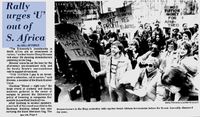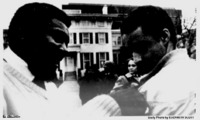The State Divestment Law
In December of 1982, Perry Bullard’s House Bill 4553 forcing the divestment of Michigan public colleges and universities from companies doing business in South Africa or the Soviet Union was finally passed by the State Senate with bipartisan support. Throughout the legislative process, the University of Michigan worked to derail the bill. At first, UM “maintained a low profile” and tried “simply to prevent it from coming up for a vote.” After the bill cleared the House, UM tried to fight it more aggressively. The University lobbied Senators and, eventually, worked with Ford Motor Company to draft a substitute bill that reflected the Regents’ position. In the end, their efforts failed. On December 31st, 1982, Republican Governor William Milliken signed the bill into law and it became Public Act 512. P.A. 512 made Michigan the first state in the country to legislate the divestment of educational institutions. The bill gave the schools until April 1st of 1984 to completely divest their stocks in companies doing business in South Africa. Support for the bill came from many different groups, ranging from churches to legislators to students. Bullard singled out several groups who had been instrumental in the bill’s passage including the Washtenaw County Coalition Against Apartheid (WCCAA), the Catholic Diocese of Lansing, and the Women’s League for Peace and Freedom. The new law called for the University of Michigan to divest about one-fifth of its $420 million portfolio. Immediately, some University administrators, Regents, and lawyers criticized the bill and began considering their options for resisting it.
Upping the Pressure
In the months between the passage of Public Act 512 and the Regents’ vote on April 14, 1983, students kept up their pressure for divestment. On January 18, 1983, the Michigan Student Assembly passed a resolution urging the Regents to obey the state law and divest. Student representative to the SAACFA, Ben Davis, warned University officials against the “‘arrogant presumption’ that continued investment [would] be conducive to social change in South Africa.” At a February 14, 1983 WCCAA rally on the Diag, Davis ridiculed the University, which had never advocated civil disobedience to state law until the divestment dispute, joking that he “didn’t know Harold Shapiro was such a devotee of Thoreau.” The WCCAA rally was well attended by both students and faculty. Speakers urged compliance with the new state divestment law, and protesters marched behind black liberation flags. One protester and member of the Black Student Union emphasized her commitment to divestment on moral grounds, declaring that “the tuition I pay is an investment in education, not in racism.” Other students wrote letters to the Regents and administration, urging compliance with P.A. 512. One student chided the Regents saying, “The University of Michigan, educating the leaders of tomorrow, must be able to distinguish right from wrong.”
February 14th proved a pivotal day, as it signaled the first concrete action by the faculty governing body, the Senate Assembly, in favor of full divestment. At their meeting that day, they debated the appropriate University response to P.A. 512. Only three faculty members opposed an otherwise unanimous decision to “ask the Regents to divest of its holdings in companies operating in South Africa.” Several people, including professors and students, participated in the debate. One of them, Leonard Suransky, a white graduate student from South Africa, encouraged compliance saying, “The attempt to justify the Sullivan Principles by comparing the fight against apartheid with the civil rights fight here ignores the fact that South African blacks have no constitutional rights at all…In such circumstances a civil rights campaign cannot be effective.” He later continued by comparing the South African leaders to Nazi sympathizers and saying, “…no corporation can change them.”
In an open letter to the Regents in The Michigan Record, signed by faculty representatives from various departments, the faculty urged University leadership to respond to the “clear message” from the University community, as well as the State of Michigan, and “say YES TO EQUALITY, YES TO DEMOCRACY in South Africa, and NO TO RACISM (sic)” through full divestiture. Furthermore, the letter systematically repudiated the Regents’ fears regarding the negative economic effects of divestment for the University, the state, and South African blacks. According to the faculty, the profitable results of divestment at the University of Wisconsin and MSU meant divestment was not only possible, but beneficial, and the consistent pleas of virtually every black South African leader for divestment, regardless of economic cost, mandated decisive action to remove University financial support. Companies such as Ford, GM, and Dow already hurt Michigan’s economy by outsourcing jobs and resources to places like South Africa, the faculty asserted, so arguments that divesting from them would hurt the state were misleading. Finally, the faculty endorsed a report from the Motor Assemblers’ and Component Workers’ Union of South Africa, “the equivalent of the UAW in South Africa,” which condemned the Sullivan Principles as a “toothless package…that allows this cruel system of apartheid to survive.”
Rather unconcerned with the economic arguments against divestment forwarded by the movement’s detractors, activists seemed focused on the moral or symbolic reasons behind divestment. A letter to the Daily from the Center for Afroamerican and African Studies (CAAS) faculty at UM explained such sentiment well:
Decisive regental action in favor of divestment would be a significant sign of support for justice and peaceful change by one of America’s leading institutions of higher learning. Such action would serve as a model for others, and thereby escalate the pressure for positive change in South Africa.
Preparing for the Regents’ Decision
Not everyone saw the issue as a simple matter of divesting or not. As the April 1983 meeting where the Regents would decide their course of action approached, UM President Harold Shapiro compiled his thoughts on the problem and sent them to the Regents. His letter reveals that he was struggling with the complexities of the divestment issue, despite his research into the subject. As the letter opens, he admits that he had “developed no final wisdom on the issue of…divestment” and he can only conclude “that well-informed, thoughtful, and socially concerned individuals have very different views on whether a U.S. presence…is, on balance, a positive or negative influence.” Shapiro goes on to say that everyone deplores the apartheid system and admits the Sullivan principles, even if fully implemented, are unlikely to play a major role in ending apartheid. However, when it came to university investments, the issue became much more complicated for him. He argues that the University has to strike a careful balance between acting in a morally responsible way and getting too involved in external political issues. He also points out that South African investments might finance “the pursuit of other highly worthy aims” and divestment might harm them. Throughout the letter, Shapiro also expresses concern for the long-term health of the University. Additionally, he acknowledges the awkward position P.A. 512 has put UM in. He says, “Although this law may be unconstitutional, it was passed by large majorities in the Senate and the House.” Furthermore, he points out that no matter what the Regents decide, it will probably alienate some people. Divestment could hurt UM’s relationship with companies that support many University activities and not divesting could anger the faculty who voted for divestment. He concludes that there is no “clear course of action on the divestment issue” and the Regents decision “will require a wise and careful balancing” of several factors.
On the day before the Regents’ voted on obeying P.A. 512, thirty-five protesters gathered outside President Shapiro’s house to greet the Regents as they arrived for a dinner meeting. The men wore black armbands and the women wore black sashes, a traditional protest symbol worn by South African women. They silently greeted the Regents with signs saying “Divest Now!” Their hopes would only partially be realized.
Sources for this page:
The Michigan Daily, January 5, 1983
The Michigan Daily, February 1, 1983
The Michigan Daily, February 4, 1983
The Michigan Daily, February 8, 1983
The Michigan Daily, February 14, 1983
The Michigan Daily, February 15, 1983
The Michigan Daily, March 18, 1983
The Michigan Daily, April 16, 1983
Perry Bullard, press release: “Senate Passes Bill to Prohibit State Educational Institutions from Investing in South Africa,” December 15, 1982, SA Press Releases, Box 25, Perry Bullard Papers, Bentley Historical Library, University of Michigan.
Perry Bullard, press release: “Governor Signs Anti-Apartheid Bill,” January 2 1983, Political Legislative Aide to State Rep Bullard South Africa Legislation Press Releases 1982-1983, Box 2, Barbara Bach papers, Bentley Historical Library, University of Michigan.
Michigan Student Assembly, “Divestment Resolution,” January 18 1983, Pro Divest, Box 7, Thomas Roach papers, Bentley Historical Library, University of Michigan
Arnold Herz, letter to Thomas Roach, April 11 1983, Pro Divest, Box 7, Thomas Roach papers, Bentley Historical Library, University of Michigan.
Phillip Kwik, letter to Thomas Roach, Feb 23 1983, Pro Divest, Box 7, Thomas Roach papers, Bentley Historical Library, University of Michigan.
Janice Love, The U.S. Anti-Apartheid Movement: Local Activism in Global Politics (New York: Praeger Publishers, 1985).


